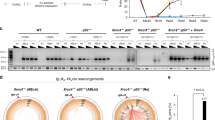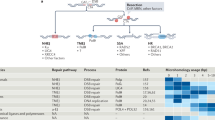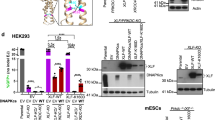Abstract
We used intrachromosomal substrates to directly monitor the effect of the cell cycle on the efficiency and the accuracy of nonhomologous end joining (NHEJ) in mammalian cells. We show that both KU and KU-independent (KU-alt) pathways are efficient when maintaining cells in G1/S, in G2/M or during dynamic progression through S phase. In addition, the accuracy of NHEJ is barely altered when the cells are blocked in G1/S or in G2/M. However, progression through S phase increases the frequency of deletions, which is a hallmark of the KU-alt pathway. Moreover, we show that the intermediates that are generated by the KU-dependent end joining of non-fully complementary ends, and which contain mismatches, nicks or gap intermediates, are less accurately processed when the cells progress through S phase. In conclusion, both KU and KU-alt processes are active throughout the cell cycle, but the repair is more error prone during S phase, both by increasing the mutagenic KU-alt pathway and decreasing the accuracy of the repair of the intermediates generated by the KU-dependent pathway.
This is a preview of subscription content, access via your institution
Access options
Subscribe to this journal
Receive 50 print issues and online access
$259.00 per year
only $5.18 per issue
Buy this article
- Purchase on Springer Link
- Instant access to full article PDF
Prices may be subject to local taxes which are calculated during checkout






Similar content being viewed by others
References
Audebert M, Salles B, Calsou P . (2004). Involvement of poly(ADP-ribose) polymerase-1 and XRCC1/DNA ligase III in an alternative route for DNA double-strand breaks rejoining. J Biol Chem 279: 55117–55126.
Ausubel F, Brent R, Kingston R, Moore D, Seidman J, Smith J et al. (1999). Current Protocols in Molecular Biology. John Wiley: Boston.
Capp JP, Boudsocq F, Bertrand P, Laroche-Clary A, Pourquier P, Lopez BS et al. (2006). The DNA polymerase lambda is required for the repair of non-compatible DNA double strand breaks by NHEJ in mammalian cells. Nucleic Acids Res 34: 2998–3007.
Capp JP, Boudsocq F, Besnard AG, Lopez BS, Cazaux C, Hoffmann JS et al. (2007). Involvement of DNA polymerase mu in the repair of a specific subset of DNA double-strand breaks in mammalian cells. Nucleic Acids Res 35: 3551–3560.
Cohen PE, Pollard JW . (2001). Regulation of meiotic recombination and prophase I progression in mammals. Bioessays 23: 996–1009.
Couedel C, Mills KD, Barchi M, Shen L, Olshen A, Johnson RD et al. (2004). Collaboration of homologous recombination and nonhomologous end-joining factors for the survival and integrity of mice and cells. Genes Dev 18: 1293–1304.
Feldmann E, Schmiemann V, Goedecke W, Reichenberger S, Pfeiffer P . (2000). DNA double-strand break repair in cell-free extracts from Ku80-deficient cells: implications for Ku serving as an alignment factor in non-homologous DNA end joining. Nucleic Acids Res 28: 2585–2596.
Ferguson DO, Sekiguchi JM, Chang S, Frank KM, Gao Y, DePinho RA et al. (2000). The nonhomologous end-joining pathway of DNA repair is required for genomic stability and the suppression of translocations. Proc Natl Acad Sci USA 97: 6630–6633.
Gao Y, Chaudhuri J, Zhu C, Davidson L, Weaver DT, Alt FW . (1998). A targeted DNA-PKcs-null mutation reveals DNA-PK-independent functions for KU in V(D)J recombination. Immunity 9: 367–376.
Gilbert DM, Neilson A, Miyazawa H, DePamphilis ML, Burhans WC . (1995). Mimosine arrests DNA synthesis at replication forks by inhibiting deoxyribonucleotide metabolism. J Biol Chem 270: 9597–9606.
Greaves MF, Wiemels J . (2003). Origins of chromosome translocations in childhood leukaemia. Nat Rev Cancer 3: 639–649.
Guirouilh-Barbat J, Huck S, Bertrand P, Pirzio L, Desmaze C, Sabatier L et al. (2004). Impact of the KU80 pathway on NHEJ-induced genome rearrangements in mammalian cells. Mol Cell 14: 611–623.
Honma M, Izumi M, Sakuraba M, Tadokoro S, Sakamoto H, Wang W et al. (2003). Deletion, rearrangement, and gene conversion; genetic consequences of chromosomal double-strand breaks in human cells. Environ Mol Mutagen 42: 288–298.
Honma M, Sakuraba M, Koizumi T, Takashima Y, Sakamoto H, Hayashi M . (2007). Non-homologous end-joining for repairing I-SceI-induced DNA double strand breaks in human cells. DNA Repair (Amst) 6: 781–788.
Jeggo PA . (1990). Studies on mammalian mutants defective in rejoining double-strand breaks in DNA. Mutat Res 239: 1–16.
Jung D, Alt FW . (2004). Unraveling V(D)J recombination; insights into gene regulation. Cell 116: 299–311.
Lalande M . (1990). A reversible arrest point in the late G1phase of the mammalian cell cycle. Exp Cell Res 186: 332–339.
Lee S, Cavallo L, Griffith J . (1997). Human p53 binds Holliday junctions strongly and facilitates their cleavage. J Biol Chem 272: 7532–7539.
Levenson V, Hamlin JL . (1993). A general protocol for evaluating the specific effects of DNA replication inhibitors. Nucleic Acids Res 21: 3997–4004.
Liang F, Han M, Romanienko PJ, Jasin M . (1998). Homology-directed repair is a major double-strand break repair pathway in mammalian cells. Proc Natl Acad Sci USA 95: 5172–5177.
Mills KD, Ferguson DO, Essers J, Eckersdorff M, Kanaar R, Alt FW . (2004). Rad54 and DNA Ligase IV cooperate to maintain mammalian chromatid stability. Genes Dev 18: 1283–1292.
Rodrigue A, Lafrance M, Gauthier MC, McDonald D, Hendzel M, West SC et al. (2006). Interplay between human DNA repair proteins at a unique double-strand break in vivo. EMBO J 25: 222–231.
Rothkamm K, Kruger I, Thompson LH, Lobrich M . (2003). Pathways of DNA double-strand break repair during the mammalian cell cycle. Mol Cell Biol 23: 5706–5715.
Saintigny Y, Delacote F, Boucher D, Averbeck D, Lopez BS . (2007). XRCC4 in G1suppresses homologous recombination in S/G2, in G1checkpoint-defective cells. Oncogene 26: 2769–2780.
Saintigny Y, Delacote F, Vares G, Petitot F, Lambert S, Averbeck D et al. (2001). Characterization of homologous recombination induced by replication inhibition in mammalian cells. EMBO J 20: 3861–3870.
Stamato TD, Dipatri A, Giaccia A . (1988). Cell-cycle-dependent repair of potentially lethal damage in the XR-1 gamma-ray-sensitive Chinese hamster ovary cell. Radiat Res 115: 325–333.
Wang H, Perrault AR, Takeda Y, Qin W, Iliakis G . (2003). Biochemical evidence for Ku-independent backup pathways of NHEJ. Nucleic Acids Res 31: 5377–5388.
Weinstock DM, Elliott B, Jasin M . (2006). A model of oncogenic rearrangements: differences between chromosomal translocation mechanisms and simple double-strand break repair. Blood 107: 777–780.
Zucman-Rossi J, Legoix P, Victor JM, Lopez B, Thomas G . (1998). Chromosome translocation based on illegitimate recombination in human tumors. Proc Natl Acad Sci USA 95: 11786–11791.
Acknowledgements
We thank Dr M Jasin for the I-SceI expression vector plasmid, and C Laulier, Drs P Bertrand, S Marcand, I Plo and D Marsh for critical reading of the manuscript. This work was supported by La Ligue Nationale contre le Cancer ‘Equipe labellisée, La Ligue 2005’, the ‘programme interorganisme ToxNuc’, INCA and ANR.
Author information
Authors and Affiliations
Corresponding author
Rights and permissions
About this article
Cite this article
Guirouilh-Barbat, J., Huck, S. & Lopez, B. S-phase progression stimulates both the mutagenic KU-independent pathway and mutagenic processing of KU-dependent intermediates, for nonhomologous end joining. Oncogene 27, 1726–1736 (2008). https://doi.org/10.1038/sj.onc.1210807
Received:
Revised:
Accepted:
Published:
Issue Date:
DOI: https://doi.org/10.1038/sj.onc.1210807



